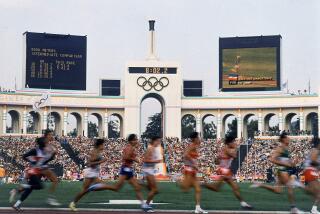The Biggest Surprise Is Who Got Record : Beamon: The 1968 Olympic champion had assumed that Lewis would be the one to do it.
For 23 years, it has often been referred to in track and field as “the moment.”
On Oct. 18, 1968, a spindly athlete named Bob Beamon flew through the air so far it seemed as if he would never come down. When he did, it was 29 feet 2 1/2 inches later. At the Olympic Games in Mexico City, he had added a stunning 21 3/4 inches to the world long jump record.
This one will endure forever, some said.
Later that year, Ernest Jokl, a professor at the University of Kentucky, said in a speech at a convention of the American Assn. for the Advancement of Science that, based on careful analysis, Beamon’s record was unlikely to be surpassed “in the lifetime of the present generation.”
He didn’t miss by much. Mike Powell was 4 in 1968.
Beamon, 22 that day, is 45 now, an administrator for the Dade County Parks and Recreation Department in Miami.
On Friday, it was almost as if he had broken 29 feet again.
“I’ll give him the message, but there’s a line of TV people here going all the way down the stairs,” Beamon’s secretary told a caller.
Earlier, Beamon had spoken to callers about losing one of sport’s greatest records.
He said he learned of Powell’s leap of 29-4 1/2 in Tokyo at 6:11 a.m. Friday, when he was awakened by a call from 1968 Olympic teammate Ron Freeman.
“For a moment, I thought Ron had an apple in his throat,” Beamon said. “There was something he wanted to tell me. He finally got the words out.
“I knew it was inevitable someone would break my record. But like everyone else, I had assumed it would be Carl Lewis. So that was a surprise to me.”
Beamon noted that he is still a record-holder.
“Remember, I still have the Olympic record,” he said. “I will always be excited about my part in Olympic history.”
How long did he think his record would last?
“We had such great jumpers in the field that day--Ralph Boston, Igor Ter-Ovanesyan, Lynn Davies--that I thought it could conceivably not last through the competition that day.”
More long jump excitement is coming, Beamon predicted.
“I hope (Powell) will enjoy being on top, that he will take the event to another dimension. I don’t think the drama is over yet. I expect these two jumpers (Powell and Lewis) will repeat their classic confrontation.”
USC track Coach Jim Bush was in Mexico City on Beamon’s world record day, working for United Press International.
“I had my glasses on Beamon during his jump, and I thought: ‘Hey, that looks like a good jump. He did everything right.’ But when they announced the distance, I said to this French guy next to me: ‘No, that can’t be right--no one’s even jumped 28 feet.’ ”
Why are world record long jumps so rare?
“The long jump is a very complex event, with many, many elements involved,” Bush said.
“A slight cross wind, a slight wind change, almost anything can make you miss. That takeoff off the board has to be perfect.
“I asked Ralph Boston once why it’s so difficult for a guy to get his steps just right in that event and he told me: ‘The trick is to just run off the board, not jump off it.’
“Even if you’re talking about highly trained, world-class athletes, your chances of hitting that takeoff board perfectly are one in thousands. See, if it weren’t so complex, Lewis, Powell, Larry Myricks . . . all those guys would have jumped 29 by now.
“That day in Mexico City . . . I thought that was the greatest achievement ever in track and field. If you rate world records, that one was the greatest.”
And so the record some thought would endure forever instead lasted 22 years 316 days. As it turned out, Jesse Owens’ world-record jump of 26-8 1/4 in 1935 lasted longer--25 years 98 days.
Owens’ record was broken by Boston at Mt. San Antonio College in Walnut during the summer of 1960. He jumped 26-11 1/4 in a pre-Olympic meet that day. Less than a year later, Boston became the first to jump 27 feet when he went 27-0 1/2 at Modesto, Calif.
Beamon’s 29-2 1/2 broke the world record of 27-4 3/4 set by Ter-Ovanesyan of the Soviet Union. Ter-Ovanesyan finished fourth that day, at 26-7 3/4. Boston was third at 26-9 1/4, and Klaus Beer of East Germany was second at 26-10 1/2.
On his first jump, Beamon fouled by about a foot. His second jump was also a foul.
Then, on a tip from Boston, Beamon put a mark on the ground a foot in front of the takeoff board.
Beamon hit the takeoff board perfectly on his next jump and soared high and far.
“That’s 28 feet,” said Boston to British jumper Lynn Davies.
When 8.90 meters was flashed on the scoreboard, Boston, Davies and Ter-Ovanesyan looked at each other. Ter-Ovanesyan, according to Davies, said: “Compared to this jump, we are as children.”
Said Davies to Boston: “I can’t go on. What is the point? We’ll all look silly.”
More to Read
Go beyond the scoreboard
Get the latest on L.A.'s teams in the daily Sports Report newsletter.
You may occasionally receive promotional content from the Los Angeles Times.








